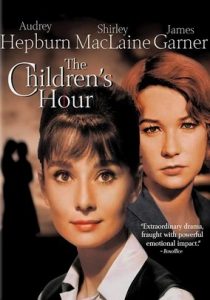The Children’s Hour-1961
Director William Wyler
Starring Audrey Hepburn, Shirley MacLaine, James Garner
Scott’s Review #620
Reviewed March 3, 2017
Grade: B+
The Children’s Hour (1961) is one of the earliest films to center around an LGBT theme and the subsequent scandals the subject would provoke in the innocent year of 1961-pre Civil Rights and pre-Sexual Revolution.
However, since the film was made in the year that it was, homosexuality was presented as something dark and bad rather than something to be accepted or even embraced.
Still, the film, and director William Wyler are brave enough to recognize the topic- with limitations to spin a compelling film rich with well-written characters and some soap opera opera-style drama.
The Children’s Hour is based on a play from 1934 and written by Lillian Hellman.
The setting appears in New England, perhaps Connecticut or Massachusetts, though the film never says the exact area.
College friends Karen (Audrey Hepburn) and Martha (Shirley MacLaine) open a private all-girls boarding school catering to the affluent community they reside in. They run the school with Martha’s Aunt Lilly, a faded Broadway actress who often hen-pecks the women.
Karen has been dating handsome obstetrician, Joe (James Garner) for two years when he proposes marriage and she hesitantly accepts, which saddens Martha.
All the while, spoiled brat child, Mary, furious over being punished by her teachers, plots revenge against Martha and Karen and embellishes a heated discussion between the ladies into a scandalous lie that she whispers to her grandmother (Fay Bainter).
The grandmother promptly tells the parents of the other students, who remove their children from the school en masse. The lie is that Karen and Martha are lovers and Mary has witnessed the two women kissing.
Meanwhile, Mary is blackmailing a fellow student, Rosalie (Veronica Cartwright) over a stolen bracelet.
Martha and Karen are ostracized by the town.
The Children’s Hour becomes even more compelling when one of the women begins to realize that she does indeed have homosexual feelings towards the other woman and has always harbored anger and resentment as well as feeling “different” from other women.
As well-written as the film is, the fact that the audience does not get to hear what Mary whispers to her grandmother is rather telling and prevents the film from being even more powerful than it is.
Also, the downbeat conclusion to the film sends a clear message that in 1961 audiences were not ready to accept lesbianism as anything to be normalized or to be proud of.
The decision was made to make it abundantly clear that one of the central characters is not a lesbian. Any uncertainty may have risked freaking out mainstream audiences at the time.
Since the traditional opposite-sex romance between Karen and Joe is at the forefront of the film, I did not witness much chemistry between actors Hepburn and Garner but might have been the point in achieving a subliminal sexual complexity.
The Children’s Hour and William Wyler deserve heaps of praise for going as far as censorship in film in 1961 would allow them to offer nuggets of progressivism mixed into a brave film.
Incidentally, Wyler made another version of this film in 1936 named These Three. Because of the Hays Code, any hint of lesbianism was forbidden causing Wyler to create a standard story of a love triangle between the three with both Martha and Karen pining after Joe.
What a difference a couple of decades make!
MacLaine and Hepburn must be credited with carrying the film and eliciting nice chemistry between the women though it is too subtle to be realized if the chemistry is really of a friendship level or a sexual nature.
And, I adore how Wyler decides to make both characters rather glamorous and avoid stereotypical characteristics.
Oscar Nominations: Best Supporting Actress-Fay Bainter, Best Sound, Best Art Direction, Black-and-White, Best Cinematography, Black-and-White, Best Costume Design, Black-and-White
